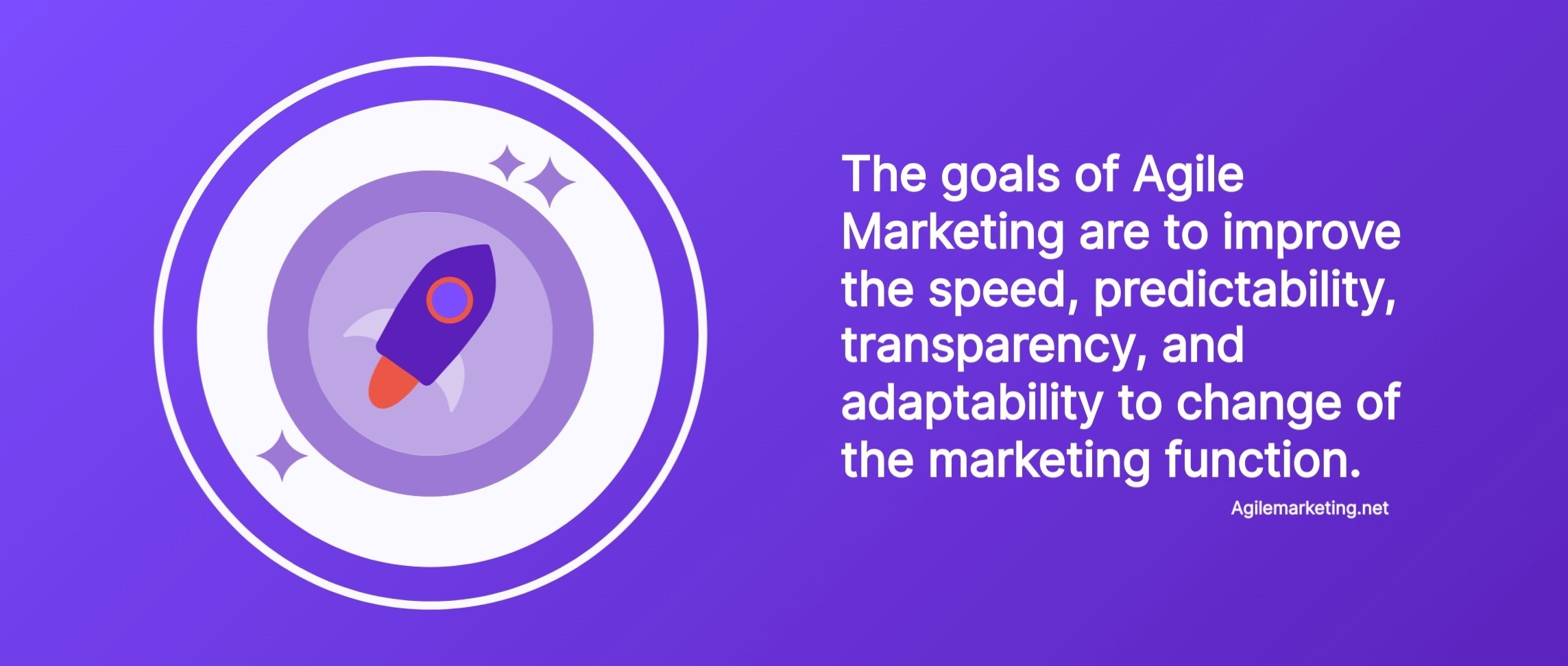How to get started with Agile marketing

You're in good company if you have Agile marketing on your radar. According to the 4th Annual State of Agile Marketing Report by Agile Sherpas and Forrester, 51% of marketers surveyed reported using Agile processes to manage their work, an increase of 10% over the previous year. And teams throughout the marketing department are using Agile: 77% of creative services, content creation and marketing operations teams use Agile.
Agile marketing enables companies to focus resources on meeting the highest value opportunities, using iterative processes that build on what works as determined by experimentation, data and other measures and discard what doesn’t work. And perhaps most importantly, Agile marketing aims for customer satisfaction through enhanced user experiences and delivering what they want, when and where they want it.
What is Agile marketing?

The fundamentals of Agile marketing date back to 2012 and the creation of the Agile Marketing Manifesto. The impetus for the manifesto was simple: marketing needed to change how it worked to excel in a digital world marked by constant, rapid and often chaotic change.
The principles outlined in the manifesto include:
Focusing on customer value and business outcomes over activity and outputs
Delivering value early and often over waiting for perfection
Learning through experiments and data over opinions and conventions
Cross-functional collaboration over silos and hierarchy
Responding to change over following a static plan
How to get started with Agile marketing
The good news is that you probably have many of the right elements. In this guide, we’ll give you strategies to put it together and make it work.
Get upper management support
It's easy to get caught up in the excitement of implementing a revolutionary methodology like Agile marketing. It's even tempting to start a pilot and test the concepts immediately. After all, that's what Agile marketers do, right? They experiment, assess the results, modify the process using lessons learned and repeat.
Tempting indeed, but you need to take your implementation step-by-step. The first step is getting upper management support and buy-in. They will want evidence that Agile marketing will deliver better results than the current process, so you will need to develop a compelling business case.
Business case requirements vary from company to company, but you should cover the following topics somewhere in your document:
Reason for improving the current process
Root cause analysis of the identified problems
Proposed solution to move forward
Measures of success
Risk mitigation
Communicate across the organization
You’ll be doing things differently with the Agile marketing methodology. This means how other teams in your organization work with you must change. Old habits like changing up a requirement via email or dropping by and requesting a change are no longer acceptable. Agile marketing enables teams to work on the right thing at the right time and over shorter periods to allow for experimentation and adjustment. It requires an unwavering focus on fewer tasks. So, you must clearly and frequently communicate how you will assess, prioritize and complete work. This internal communication program might be the perfect first project for your Agile team.
Start small with your best team
To manage the risks of implementing an Agile marketing transformation, both real and perceived, start with a small team to prove the concept. Look for people with a demonstrated willingness to change and flexibility in accomplishing their work.
You want a team with the skills and ability to manage a marketing effort from concept development through implementation. You’ll need people for data analysis, content creation (copy, graphics, and other media) and familiarity with posting and publishing to your company’s digital channels. Ideally, your team can use data to identify the target markets, create content to stimulate action, publish the content where your audience will see it and analyze results to fuel improvements.
Team focus and location
Management should release your team from their daily responsibilities so they can concentrate on the pilot. Creating a dedicated space for Agile teams to work together is popular. However, with today’s hybrid work and remote work locations, it may be impractical. A more realistic proof of concept will be having your team operate like they do today. After all, once you get the green light to proceed, you’ll be working in this environment.
Select your management methodology
With everything else about your proof of concept being new, using a proven and documented tool means one less thing to worry about. Also, using a recognized methodology demonstrates that you’ll manage the effort using proven techniques and approaches. So, which do you choose, Scrum, Kanban or Scrumban? Let’s take a quick look at each.
Scrum
The Scrum framework was created to manage software development, the original use of the Agile methodology. Scrum’s goals are to create a work environment of transparency through communication, adaptation to change and completing high-priority work through short, focused sprints instead of lengthy development cycles. The sprint protects the team from “scope creep” and changes to development requirements during the sprint’s completion.
The Scrum methodology has two main elements: ceremonies or events and roles. The events create a regular, predictable communication process within the team, facilitating collaboration and better development results. Events include:
Sprint planning: Defining the work involved and what “done” looks like
Daily scrum, aka daily standup: Short status meetings
Sprint review: Presenting work product to stakeholders
Sprint retrospective: Planning ways to increase work quality and effectiveness
Roles include the scrum master, the project owner and developers/team members. The scrum master and project owner are often the same person.
The Scrum methodology provides excellent structure and role definition. Stakeholders agree on the scope of work and what “done” looks like. Once the sprint begins, changes aren’t allowed, enabling the team to focus on the agreed-upon work. If changes are needed, you can incorporate them during the sprint into the next iteration.
On the downside, Scrum requires a significant investment in training and education and may be too rigid for some marketing organizations.
The Kanban approach
The Kanban approach is a less structured tool and focuses on managing work in progress (WIP). Kanban means “billboard” or “signboard” in Japanese, and the methodology takes its name from using a visual representation of workflow to manage high-priority tasks.
Here’s how it’s commonly implemented: The team divides a large whiteboard into columns representing their standard project workflow from start to finish. Sticky notes represent projects; as a project advances, its sticky note moves to the next column. Columns represent each step in the workflow, so headings reflect the process from start to finish. A workflow might include headings such as:
Backlog/queue
Copy
Design
Publish
Done
Review

There are many benefits from the Kanban work visualization approach. First, anyone looking at the board sees the team’s WIP and workload. Second, it enables the team to prioritize their backlog, moving the highest-value tasks to the front of the line where they belong. Third, it constantly communicates progress, which is highly motivating. Software apps abound that offer digital Kanban boards you can share with team members and stakeholders around the globe.
Just as when using the Scrum sprint, limiting the amount of work in progress for your Agile marketing team is essential. If you allow too much work to start, your team will be back where they were before, chasing too many rabbits and not catching any.
The Scrumban or Hybrid approach
Purists will argue that there are only two options for managing an Agile team: Scrum and Kanban. While that may be true for software development, many Agile marketing teams prefer to use a hybrid management framework. According to the 4th Annual State of Agile Marketing Report, 53% of the Agile marketing teams surveyed use a hybrid approach.
An excellent hybrid solution combines the daily stand-up meeting, the Kanban WIP management approach and the Scrum sprint retrospective. Stand-up meetings ensures the meetings are short and to the point, allowing your team to report progress, identify issues, keep everyone informed and get back to work. If you have enough team members working onsite instead of remote, you can buy stand-up meeting tables designed for this purpose. The team can track their WIP on a large whiteboard, digitally or both.
The retrospective becomes the learning part of the Agile marketing effort. Your team tracks and measures results against goals and expectations. At the appropriate time, they review what worked well and what didn’t. Your team adjusts the marketing effort and it’s relaunched.
About Contentstack
The Contentstack team comprises highly skilled professionals specializing in product marketing, customer acquisition and retention, and digital marketing strategy. With extensive experience holding senior positions in notable technology companies across various sectors, they bring diverse backgrounds and deep industry knowledge to deliver impactful solutions.
Contentstack stands out in the composable DXP and Headless CMS markets with an impressive track record of 87 G2 user awards, 6 analyst recognitions, and 3 industry accolades, showcasing its robust market presence and user satisfaction.
Check out our case studies to see why industry-leading companies trust Contentstack.
Experience the power of Contentstack's award-winning platform by scheduling a demo, starting a free trial, or joining a small group demo today.
Follow Contentstack on Linkedin




.svg?format=pjpg&auto=webp)
.svg?format=pjpg&auto=webp)
.png?format=pjpg&auto=webp)






.png?format=pjpg&auto=webp)

